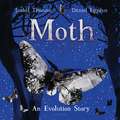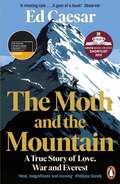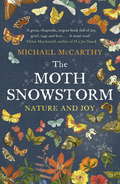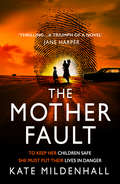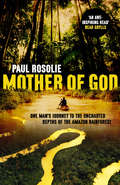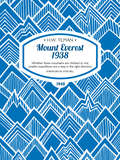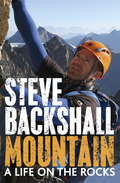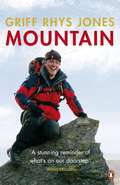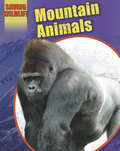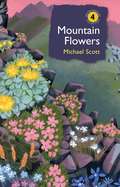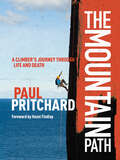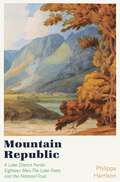- Table View
- List View
Moth
by Isabel ThomasPowerful and visually spectacular, Moth is the remarkable evolution story that captures the struggle of animal survival against the background of an evolving human world in a unique and atmospheric introduction to Darwin's theory of Natural Selection.“This is a story of light and dark…”Against a lush backdrop of lichen-covered trees, the peppered moth lies hidden. Until the world begins to change...Along come people with their magnificent machines which stain the land with soot. In a beautiful landscape changed by humans how will one little moth survive?A clever picture book text about the extraordinary way in which animals have evolved, intertwined with the complication of human intervention. This remarkable retelling of the story of the peppered moth is the perfect introduction to natural selection and evolution for children.
The Moth and the Mountain: A True Story of Love, War and Everest
by Ed Caesar'One of the best books ever written about the early attempts to conquer Everest. A fine, fine slice of history by a truly special writer who proves time and time again that he is among the best of his generation' Dan Jones, author of The PlantagenetsThe untold story of Britain's most mysterious mountaineering legend - Maurice Wilson - and his heroic attempt to climb Everest. Alone.In the 1930s, as official government expeditions set their sights on conquering Everest, a little-known World War I veteran named Maurice Wilson conceived his own crazy, beautiful plan: he would fly a Gipsy Moth aeroplane from England to Everest, crash land on its lower slopes, then become the first person to reach its summit - all utterly alone. Wilson didn't know how to climb. He barely knew how to fly. But he had pluck, daring and a vision - he wanted to be the first man to stand on top of the world. Traumatised by his wartime experiences and leaving behind a trail of broken hearts, Wilson believed that Everest could redeem him.This is the tale of an adventurer unlike any you have ever encountered: an unforgettable story about the power of the human spirit in the face of adversity. Maurice Wilson is a man written out of the history books - dismissed as an eccentric and a charlatan by many, but held in the highest regard by renowned mountaineers such as Reinhold Messner. The Moth and the Mountain restores him to his rightful place in the annals of Everest and in doing so attempts to answer that perennial question - why do we climb mountains?'A towering, tragic tale rescued from oblivion by Ed Caesar's magnificent writing' Dan Snow'Absolutely bursting with life . . . the lure of adventure, hair-raising tales of amateur aviation, and, above all, the beauty and madness of the quest to ascend Earth's tallest summit' Patrick Radden Keefe, author of the Orwell Prize-winning Say Nothing'It's hard to imagine a finer tribute to one of Everest's forgotten heroes' Elizabeth Day
The Moth Snowstorm: Nature and Joy
by Michael McCarthyA great, rhapsodic, urgent book full of joy, grief, rage and love . . . A must-read' Helen Macdonald, author of H is for HawkNature has many gifts for us, but perhaps the greatest of them all is joy; the intense delight we can take in the natural world, in its beauty, in the wonder it can offer us, in the peace it can provide - feelings stemming ultimately from our own unbreakable links to nature, which mean that we cannot be fully human if we are separate from it. In The Moth Snowstorm Michael McCarthy, one of Britain's leading writers on the environment, proposes this joy as a defence of a natural world which is ever more threatened, and which, he argues, is inadequately served by the two defences put forward hitherto: sustainable development and the recognition of ecosystem services.Drawing on a wealth of memorable experiences from a lifetime of watching and thinking about wildlife and natural landscapes, The Moth Snowstorm not only presents a new way of looking at the world around us, but effortlessly blends with it a remarkable and moving memoir of childhood trauma from which love of the natural world emerged. It is a powerful, timely, and wholly original book which comes at a time when nature has never needed it more.
The Mother Fault
by Kate Mildenhall‘Thrilling…a triumph of a novel’ JANE HARPER ‘Beautiful writing, emotional depth, page-turning plot’ CHRIS HAMMER In a futuristic world, danger awaits… if you loved THE LAST and THE HANDMAID’S TALE you will love this!
Mother of God: One man’s journey to the uncharted depths of the Amazon rainforest
by Paul RosolieMadre de Dios – ‘Mother of God’ – is a place where the Andean Cloud Forest intermingles with the steaming tropical jungle at the head of the Amazon river. Here can be found the greatest proliferation of living species that has ever existed on Earth, ever. And it is a place which is now under grave threat.Paul Rosolie has travelled to the very heart of this wilderness in search of rare flora and fauna. His adventures – with giant anacondas, huge cayman, the mighty jaguar and one very small anteater – are by turn thrilling, terrifying and revelatory. Paul crosses some of the world’s harshest terrain and encounters some of its most extreme weather conditions. He battles with life-threatening tropical diseases and the extreme mental challenges presented by being alone in the heart of the jungle.Mother of God is an astonishing tale of adventure and survival, set in one of the world’s few remaining truly wild places. It’s a story of nature, red in tooth and claw, and how we must both respect its awesome power and protect its extraordinary glory.
Motorized Obsessions: Life, Liberty, and the Small-Bore Engine
by Paul R. JosephsonFrom dirt bikes and jet skis to weed wackers and snowblowers, machines powered by small gas engines have become a permanent—and loud—fixture in American culture. But fifty years of high-speed fun and pristine lawns have not come without cost.In the first comprehensive history of the small-bore engine and the technology it powers, Paul R. Josephson explores the political, environmental, and public health issues surrounding one of America's most dangerous pastimes. Each chapter tells the story of an ecosystem within the United States and the devices that wreak havoc on it—personal watercraft (PWCs) on inland lakes and rivers; all-terrain vehicles (ATVs) in deserts and forests; lawn mowers and leaf blowers in suburbia. In addition to environmental impacts, Josephson discusses the development and promotion of these technologies, the legal and regulatory efforts made to improve their safety and environmental soundness, and the role of owners' clubs in encouraging responsible operation.Synthesizing information from medical journals, recent environmental research, nongovernmental organizations, and manufacturers, Josephson's compelling history leads to one irrefutable conclusion: these machines cannot be operated without loss of life and loss of habitat.
Mount Everest 1938: Whether these mountains are climbed or not, smaller expeditions are a step in the right direction (H.W. Tilman: The Collected Edition)
by H.W. Tilman‘Whether these mountains are climbed or not, smaller expeditions are a step in the right direction.’It’s 1938, the British have thrown everything they’ve got at Everest but they’ve still not reached the summit. War in Europe seems inevitable; the Empire is shrinking. Still reeling from failure in 1936, the British are granted one more permit by the Tibetans, one more chance to climb the mountain. Only limited resources are available, so can a small team be assembled and succeed where larger teams have failed?H.W. Tilman is the obvious choice to lead a select team made up of some of the greatest British mountaineers history has ever known, including Eric Shipton, Frank Smythe and Noel Odell. Indeed, Tilman favours this lightweight approach. He carries oxygen but doesn’t trust it or think it ethical to use it himself, and refuses to take luxuries on the expedition, although he does regret leaving a case of champagne behind for most of his time on the mountain.On the mountain, the team is cold, the weather very wintery. It is with amazing fortitude that they establish a camp six at all, thanks in part to a Sherpa going by the family name of Tensing. Tilman carries to the high camp, but exhausted he retreats, leaving Smythe and Shipton to settle in for the night. He records in his diary, ‘Frank and Eric going well—think they may do it.’ But the monsoon is fast approaching …In Mount Everest 1938, first published in 1948, Tilman writes that it is difficult to give the layman much idea of the actual difficulties of the last 2,000 feet of Everest. He returns to the high camp and, in exceptional style, they try for the ridge, the route to the summit and those immense difficulties of the few remaining feet.
Mountain: A Life on the Rocks
by Steve BackshallSteve Backshall's love affair with the mountains has taken him to some of the world's wildest places, environments that have the power to make a human being feel very small, very vulnerable and very alive. MOUNTAIN: A LIFE OF THE ROCKS is an account of his most breathtaking expeditions: heading into the 'Death Zone' on the roof of the world in the Himalayas, and picking a precarious route up hundreds of metres of rock in the Arctic and Alps. There are expeditions of exploration, as Steve makes the first ascent of jungle peaks and scales the tabletop mountains of the 'Lost World', Venezuela's Gran Sabana, in search of undiscovered animal species on their summits. Steve recalls his apprenticeship in the art of mountaineering with the Indian army, and the terror and near-disaster of some of his more ill-fated adventures, including the aftermath of the fall that should have ended his life.This is a tale of terror and ecstasy, a book that tries to get to the heart of why we risk our lives to climb and conquer. But most of all, MOUNTAIN is a love letter to the wilderness, from one of the world's most adventurous spirits.
Mountain: Exploring Britain's High Places
by Griff Rhys JonesGriff Rhys Jones was a mountain virgin. So when it was suggested that he might like to go up a few of Britain’s peaks, he rightly asked: isn’t there someone better qualified? Apparently not. So Griff was duly dispatched across the rooftops of England, Scotland and Wales to explore some of the roughest, most arduous – not to mention most beautiful – terrain, and to meet those who live daily in such thin-aired wilds. Climbing the big mountains like Snowdon, Ben Nevis and Scafell Pike and many others besides gave Griff an insight into the passion and devotion our high places inspire – and turned a mountain virgin into a mountaineer. Well almost …
Mountain Aesthetics in Early Modern Latin Literature
by William M. BartonIn the late Renaissance and Early Modern period, man’s relationship to nature changed dramatically. An important part of this change occurred in the way that beauty was perceived in the natural world and in the particular features which became privileged objects of aesthetic gratification. This study explores the shift in aesthetic attitude towards the mountain that took place between 1450 and 1750. Over the course of these 300 years the mountain transformed from a fearful and ugly place to one of beauty and splendor. Accepted scholarly opinion claims that this change took place in the vernacular literature of the early and mid-18th century. Based on previously unknown and unstudied material, this volume now contends that it took place earlier in the Latin literature of the late Renaissance and Early Modern period. The aesthetic attitude shift towards the mountain had its catalysts in two broad spheres: the development of an idea of ‘landscape’ in the geographical and artistic traditions of the 16th century on the one hand, and the increasing amount of scientific and theological investigation dedicated to the mountain on the other, reaching a pinnacle in the late 17th and early 18th centuries. The new Latin evidence for the change in aesthetic attitude towards the mountain unearthed in the course of this study brings material to light which is relevant for the current philosophical debate in environmental aesthetics. The book’s concluding chapter shows how understanding the processes that produced the late Renaissance and Early Modern shift in aesthetic attitude towards the mountain can reveal important information about the modern aesthetic appreciation of nature. Alongside a standard bibliography of primary literature, this volume also offers an extended annotated bibliography of further Latin texts on the mountains from the Renaissance and Early Modern period. This critical bibliography is the first of its kind and constitutes an essential tool for further study in the field.
Mountain Aesthetics in Early Modern Latin Literature
by William M. BartonIn the late Renaissance and Early Modern period, man’s relationship to nature changed dramatically. An important part of this change occurred in the way that beauty was perceived in the natural world and in the particular features which became privileged objects of aesthetic gratification. This study explores the shift in aesthetic attitude towards the mountain that took place between 1450 and 1750. Over the course of these 300 years the mountain transformed from a fearful and ugly place to one of beauty and splendor. Accepted scholarly opinion claims that this change took place in the vernacular literature of the early and mid-18th century. Based on previously unknown and unstudied material, this volume now contends that it took place earlier in the Latin literature of the late Renaissance and Early Modern period. The aesthetic attitude shift towards the mountain had its catalysts in two broad spheres: the development of an idea of ‘landscape’ in the geographical and artistic traditions of the 16th century on the one hand, and the increasing amount of scientific and theological investigation dedicated to the mountain on the other, reaching a pinnacle in the late 17th and early 18th centuries. The new Latin evidence for the change in aesthetic attitude towards the mountain unearthed in the course of this study brings material to light which is relevant for the current philosophical debate in environmental aesthetics. The book’s concluding chapter shows how understanding the processes that produced the late Renaissance and Early Modern shift in aesthetic attitude towards the mountain can reveal important information about the modern aesthetic appreciation of nature. Alongside a standard bibliography of primary literature, this volume also offers an extended annotated bibliography of further Latin texts on the mountains from the Renaissance and Early Modern period. This critical bibliography is the first of its kind and constitutes an essential tool for further study in the field.
Mountain Amnesia (Colorado Prize for Poetry)
by Gale Marie ThompsonIn Mountain Amnesia, Thompson’s poems rebuild a new world—and self—in the wake of destruction and loss. Influenced by the landscape of rural Appalachia, these poems depict a nature relentlessly working on its own disappearance for survival. Decaying plants and animal remains are housed in the same world as ramps and bellflowers on the cusp of blooming. These poems do not placate or cover up the inevitability of death, but rather use this knowledge to seek connection and make meaning: “how little and yet / how much it matters to count the dead.” Mountain Amnesia seeks a path through destruction, using ruin to clear the way for new beginnings; or, as Thompson writes, “the painful, florid bloom of passing forward.” This collectionis a testament to survival and resilience, and animal encounters—the lonely fox, the folded fawn, the returning whale, the emerging voles—become new myths along the way. Mountain Amnesia also explores the question of how implicated or dependent we are on the lives and actions of others. What does it mean to be accountable to and responsible for those around you? How are we implicated in others’ crimes? What can we do in the aftermath? The poems in this collection explore the limits of knowing and seeing, and how we come to be known and seen: “I ask the world for its bandage /of meaning.” Mountain Amnesia both pursues and surrenders to these limits of knowing, narrowing the vast distances between ourselves and others.
The Mountain and the Politics of Representation (Liverpool Studies in the Politics of Popular Culture)
The stories we tell, published or otherwise, condition our mountain experiences in practice and reinforce cultural memory and representation. Yet, as this book and the authors within it set out to demonstrate, if we look beyond the boundaries of this ‘singular white history’ there is a rich diversity of stories to tell. This volume contributes to a growing body of scholarship that calls for a heterogeneity of voices in mountain memoir genres. For the first time, this diverse scholarship interrogates how mountaineering literary and media culture impact bodies, spaces, and places, in order to nuance how commodification intersects across social categories and is embodied in multi-dimensional ways. In this volume, we explore a burgeoning tradition of mountaineering literature, of cinema and of memoir to appreciate difference, beyond the habitual heroic, white male, adventurer that dominates screens and bookshelves. Through exploring multidimensional axes of social differentiation from gender, race, class, and age to dis/ability and sexuality, the book will demonstrate how commodification is embodied through representation in mountaineering literature, media, film and memoir in mountaineering spaces. Amongst our aims, this book intends to understand how multiple social dimensions overlap and work to produce independent systems of exclusion and inclusion that focus on untraditional ways to be a mountaineer.
Mountain Animals (Saving Wildlife)
by Sonya NewlandMountain Animals looks at efforts to save the animals that have learned to survive in the world's harsh mountain regions -- high among the peaks and in the forested mountain slopes.It is part of the Saving Wildlife series, which investigates the world's endangered species in the context of their different environments.
Mountain Flowers (British Wildlife Collection)
by Michael Scott“Mountain flowers are the most romantic in our flora, exquisite, enigmatic and, often, remote from human habitation. Michael Scott has not only seen them all but has roamed every part of the hill scenery of Britainand brings to his subject passion, learning and hands-on experience. This is field botany at its best, engrossing, exciting and full of wonder.”PETER MARRENBritain's mountains and exposed sub-arctic regions of the far north are home to a remarkable range of specialist flowers, shrubs and ferns that are able to thrive on our islands thanks to a combination of conditions seldom found in mainland Europe. The peculiarities of their occurrence here, at unusually low altitudes for typically alpine species and uncommonly far south for arctic species, make their ecologyespecially intriguing. In this invigorating journey from the Lizard of Cornwall to Unst in Shetland, Michael Scott examines Britain's richest upland sites, bringing an important 21st-century perspective to our understanding of the flora along the way. Lavishly illustrated, Mountain Flowers has much to offer wild flower enthusiasts and botanists, including detailed profiles of over 150 of the plants most characteristic of our montane regions. It will prove an indispensable companion for hillwalkers and climbers wanting to learn more about the enigmatic species that are such an intrinsic part of the British mountain landscape.- Featuring over 150 mountain plants, with 20 extended profiles for the most enigmatic species- Illustrated with over 340 colour photographs of plants and their spectacular habitats- Jacket artwork by Carry Akroyd
Mountain Flowers (British Wildlife Collection)
by Michael Scott“Mountain flowers are the most romantic in our flora, exquisite, enigmatic and, often, remote from human habitation. Michael Scott has not only seen them all but has roamed every part of the hill scenery of Britainand brings to his subject passion, learning and hands-on experience. This is field botany at its best, engrossing, exciting and full of wonder.”PETER MARRENBritain's mountains and exposed sub-arctic regions of the far north are home to a remarkable range of specialist flowers, shrubs and ferns that are able to thrive on our islands thanks to a combination of conditions seldom found in mainland Europe. The peculiarities of their occurrence here, at unusually low altitudes for typically alpine species and uncommonly far south for arctic species, make their ecologyespecially intriguing. In this invigorating journey from the Lizard of Cornwall to Unst in Shetland, Michael Scott examines Britain's richest upland sites, bringing an important 21st-century perspective to our understanding of the flora along the way. Lavishly illustrated, Mountain Flowers has much to offer wild flower enthusiasts and botanists, including detailed profiles of over 150 of the plants most characteristic of our montane regions. It will prove an indispensable companion for hillwalkers and climbers wanting to learn more about the enigmatic species that are such an intrinsic part of the British mountain landscape.- Featuring over 150 mountain plants, with 20 extended profiles for the most enigmatic species- Illustrated with over 340 colour photographs of plants and their spectacular habitats- Jacket artwork by Carry Akroyd
The Mountain in the Sea
by Ray Nayler'I loved this novel's brain and heart'DAVID MITCHELL, AUTHOR OF CLOUD ATLAS'A first-rate speculative thriller, by turns fascinating, brutal, powerful, and redemptive'JEFF VANDERMEER, AUTHOR OF ANNIHILATIONThere are creatures in the water of Con Dao. To the locals, they're monsters. To the corporate owners of the island, an opportunity. To the team of three sent to study them, a revelation. Their minds are unlike ours. Their bodies are malleable, transformable, shifting. They can communicate. And they want us to leave.When pioneering marine biologist Dr. Ha Nguyen is offered the chance to travel to the remote Con Dao Archipelago to investigate a highly intelligent, dangerous octopus species, she doesn't pause long enough to look at the fine print. DIANIMA- a transnational tech corporation best known for its groundbreaking work in artificial intelligence - has purchased the islands, evacuated their population and sealed the archipelago off from the world so that Nguyen can focus on her research.But the stakes are high: the octopuses hold the key to unprecedented breakthroughs in extrahuman intelligence and there are vast fortunes to be made by whoever can take advantage of their advancements. And no one has yet asked the octopuses what they think. And what they might do about it.
Mountain Landscapes in Transition: Effects of Land Use and Climate Change (Sustainable Development Goals Series)
by R. B. Singh Udo Schickhoff Suraj MalThis book compiles available knowledge of the response of mountain ecosystems to recent climate and land use change and intends to bridge the gap between science, policy and the community concerned. The chapters present key concepts, major drivers and key processes of mountain response, providing transdisciplinary orientation to mountain studies incorporating experiences of academics, community leaders and policy-makers from developed and less developed countries. The book chapters are arranged in two sections. The first section concerns the response processes of mountain environments to climate change. This section addresses climate change itself (past, current and future changes of temperature and precipitation) and its impacts on the cryosphere, hydrosphere, biosphere, and human-environment systems. The second section focuses on the response processes of mountain environments to land use/land cover change. The case studies address effects of changing agriculture and pastoralism, forest/water resources management and urbanization processes, landscape management, and biodiversity conservation. The book is designed as an interdisciplinary publication which critically evaluates developments in mountains of the world with contributions from both social and natural sciences.
Mountain Man: 446 Mountains. Six months. One record-breaking adventure
by James ForrestNicknamed 'Mountain Man' by the Sunday Telegraph, James Forrest is the record-breaking adventurer who climbed every mountain in England and Wales in just six months – the fastest ever time. Solo and unsupported, he walked over 1,000 miles and ascended five times the height of Everest during his 446-peak challenge. And he did it all on his days off from work, proving it is possible to integrate an epic adventure into your everyday life.From collapsing tents and horrific storms to near-fatal mountaineering mishaps, James endured his fair share of hardship out in the hills. But the good times far outweighed the bad. He slept wild under the stars, met eccentric locals, and exchanged the 21st century social media bubble for a simpler, more peaceful existence. What did he learn along the way? That life is more fulfilling when you switch off your phone and climb a mountain. Readers will be inspired and motivated by James's amazing adventure, and so the book concludes with a section on how YOU can achieve your next adventure – whether it's something to get the kids involved in at half term, a fun challenge to tackle solo or with friends, or, like James's, a record-breaking attempt of epic proportions, James will guide you through everything you need to do to plan and execute your adventure, as well as give you some great ideas too.
Mountain Man: 446 Mountains. Six months. One record-breaking adventure
by James ForrestNicknamed 'Mountain Man' by the Sunday Telegraph, James Forrest is the record-breaking adventurer who climbed every mountain in England and Wales in just six months – the fastest ever time. Solo and unsupported, he walked over 1,000 miles and ascended five times the height of Everest during his 446-peak challenge. And he did it all on his days off from work, proving it is possible to integrate an epic adventure into your everyday life.From collapsing tents and horrific storms to near-fatal mountaineering mishaps, James endured his fair share of hardship out in the hills. But the good times far outweighed the bad. He slept wild under the stars, met eccentric locals, and exchanged the 21st century social media bubble for a simpler, more peaceful existence. What did he learn along the way? That life is more fulfilling when you switch off your phone and climb a mountain. Readers will be inspired and motivated by James's amazing adventure, and so the book concludes with a section on how YOU can achieve your next adventure – whether it's something to get the kids involved in at half term, a fun challenge to tackle solo or with friends, or, like James's, a record-breaking attempt of epic proportions, James will guide you through everything you need to do to plan and execute your adventure, as well as give you some great ideas too.
Mountain Meteorology: Fundamentals and Applications
by C. David WhitemanMountain Meteorology: Fundamentals and Applications offers first an introduction to the basic principles and concepts of mountain meteorology, then goes on to discuss their application in natural resources management. It includes over two hundred beautiful, full-color photographs, figures, and diagrams, as well as observable indicators of atmospheric processes--such as winds, temperature, and clouds--to facilitate the recognition of weather systems and events for a variety of readers. It is ideal for those who spend time in or near mountains and whose daily activities are affected by weather. As a comprehensive work filled with diverse examples and colorful illustrations, it is essential for professionals, scholars, and students of meteorology.
Mountain Meteorology: Fundamentals and Applications
by C. David WhitemanMountain Meteorology: Fundamentals and Applications offers first an introduction to the basic principles and concepts of mountain meteorology, then goes on to discuss their application in natural resources management. It includes over two hundred beautiful, full-color photographs, figures, and diagrams, as well as observable indicators of atmospheric processes--such as winds, temperature, and clouds--to facilitate the recognition of weather systems and events for a variety of readers. It is ideal for those who spend time in or near mountains and whose daily activities are affected by weather. As a comprehensive work filled with diverse examples and colorful illustrations, it is essential for professionals, scholars, and students of meteorology.
The Mountain Path: A climber's journey through life and death
by Paul Pritchard‘All I wanted to do was go to sleep. And I was certain that if I did drift off, it would be for the last time.’In 1998, Paul Pritchard was struck on the head by a falling rock as he climbed a sea stack in Tasmania called the Totem Pole. Close to death, waiting for hours for rescue, Pritchard kept himself going with a promise that given the chance, he would ‘at least attempt to live’.Left hemiplegic by his injury, Pritchard has spent the last two decades attempting to live, taking on adventures that seemed impossible for someone so badly injured while plumbing the depths of a mind almost snuffed out by his passion for climbing.Not content to simply survive, Pritchard finds ways to return to his old life, cycling across Tibet and expanding his mind on gruelling meditation courses, revisiting the past and understanding his compulsion for risk. Finally, he returns to climb the Totem Pole, the place where his life was almost extinguished.The Mountain Path is an adventure book like no other, an exploration of a healing brain, a journey into philosophy and psychology, a test of will and a triumph of hope.
Mountain Republic: A Lake District Parish - Eighteen Men, The Lake Poets and the National Trust
by Philippa HarrisonAn affectionate but meticulously researched history of one of the most beautiful and best-loved corners of England – Crosthwaite Parish, nestling deep within the mountains and valleys of the Lake District.'A unique contribution to English history' Hunter Davies'A delightful, refreshingly written book, attentive to social detail and telling the only story that matters – history' Simon Jenkins'A wonderful book' Margaret Drabble'A completely fresh perspective on the Lakes and Lake Poets... I hugely enjoyed it' Andrew MarrBounded by the peaks of Scafell, Skiddaw and Helvellyn, and embracing such well-known landmarks as Borrowdale, Derwentwater and Keswick, it lies within the heart of the Lake Poets' landscape and its rugged terrain excites passion in all those who know it.The Parish also boasts a remarkable history. Its 90 square miles were governed, from medieval times, by eighteen annually chosen 'customary tenants'; ancestors of the people who later prompted Wordsworth's portrayal of the area as 'a perfect Republic of Shepherds and agriculturalists'. His fellow poet Robert Southey lived within the Parish for forty years, was an active parishioner and rests in St Kentigern's churchyard. Here he is given his rightful position as a Lake Poet. In the nineteenth century, the Victorian state killed off the old parish system, sweeping away the egalitarian rule of the Eighteen Men. But a degree of redemption was at hand. Canon Rawnsley, vicar of Crosthwaite from 1883, pledged to defend the Lake District for future generations. So the Parish was at the heart of the creation of the National Trust and blazed a trail for a wider movement to preserve the English landscape.Writing with a historian's rigour and bearing aloft the banner of the Lake District statesmen, Philippa Harrison has produced a magisterial and fascinating record of a parish with a unique social, cultural and aesthetic resonance in English history.
